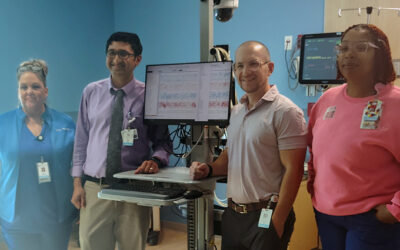When Nicholas LeBlanc, MD, and his surgical team perform an operation at Our Lady of the Lake Regional Medical Center in Baton Rouge, there’s a high likelihood they will do so using the latest robotic technology.
“The robot allows better visualization and maneuverability in tight spaces,” said Dr. LeBlanc, a thoracic surgeon. “As the chest comes to an apex at the neck, it’s a smaller space that is much easier to access with a robot than larger, open incisions. We use the robot arms to hold a camera as well as retract delicate organs and tissues. As a surgeon, it’s almost like having a third arm. We are also combining robotic platforms for difficult to locate lung nodules. We use CT scans and the robotic bronchoscope to map and navigate to small lesions that would otherwise be near impossible to find during surgery. We inject a special dye at the target lesion and then use a special camera during the operation to identify the dye, and thus the nodule. The robotic technology is helping us find the proverbial needle in the haystack.”
Dr. LeBlanc is part of Our Lady of the Lake Robotic Surgery Institute, an innovation program that continues to set the standard for such operations in the Gulf South region. Using robotic technology, surgeons at Our Lady of the Lake Health are able to treat a broad range of conditions, including cancer, hernias, gallbladder removal, obesity and much more.
The surgeons have complete control over the robots in the operating room, Dr. LeBlanc noted. This means the surgeons can maneuver the robotic arms throughout the body using its advanced technology and tools to move forward with the procedure.
“I move the arms where I want them to go,” Dr. LeBlanc said. “I put a scope where I want it, and it locks in place. The robot itself isn’t acting or thinking independently. It is an incredible assistant that allows us to do these operations in the safest and most effective manner possible.”
Dr. LeBlanc emphasized that he and other surgeons at Our Lady of the Lake Health will never use robotic technology to cut corners and will switch mid-operation to an open procedure if that is best for the patient. Although such situations are rare, they can occasionally occur if the surgical area appears to involve blood vessels that may need reconstruction or if the patient’s blood pressure remains low, which is an indication they are not tolerating the minimally invasive surgical procedure.
However, most patients do well with robotic-assisted surgeries and tend to have much better overall outcomes. This includes less pain after the operation and shorter hospital stays following a procedure.
“The data now is almost unequivocal that you have fewer complications from things like pneumonia, infections and blood clots because the pain is much lower and patients are walking earlier – the expectation is the same day of the operation. If we operate in the morning, most patients are walking around that afternoon,” Dr. LeBlanc said. “We now have patients going home as early as the next day following a lobectomy or five to six days following an esophagectomy. With an open procedure, that could be a five-to-seven-day hospital stay after a lobectomy or well over a week following an esophagectomy. People are now able to return to their normal activities in short order. By the time we see people in post-op clinic in two or three weeks, most are ready to go back to work and get back to their regular lives.”
Robotic surgery services are now provided at both the Our Lady of the Lake Robotic Surgery Institute in Baton Rouge and Our Lady of the Lake Ascension. Physicians from general surgery as well as specialties such as colorectal, urology, oncology, bariatric and thoracic are trained and able to offer such services to patients. In addition, Our Lady of the Lake experts in Baton Rouge have helped to train hundreds of surgeons across the country and have earned numerous awards and recognitions.
For more information or to schedule a consultation, call the Our Lady of the Lake Patient Navigation line at (225) 374-0053.




